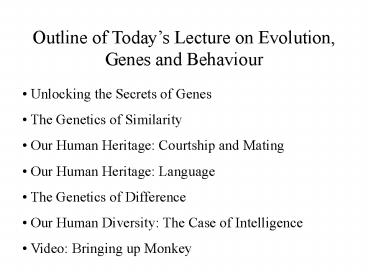Outline of Todays Lecture on Evolution, Genes and Behaviour - PowerPoint PPT Presentation
1 / 19
Title:
Outline of Todays Lecture on Evolution, Genes and Behaviour
Description:
Outline of Today's Lecture on Evolution, Genes and Behaviour. Unlocking the ... fertile females and to try and inseminate as many females as possible in order ... – PowerPoint PPT presentation
Number of Views:27
Avg rating:3.0/5.0
Title: Outline of Todays Lecture on Evolution, Genes and Behaviour
1
Outline of Todays Lecture on Evolution, Genes
and Behaviour
- Unlocking the Secrets of Genes
- The Genetics of Similarity
- Our Human Heritage Courtship and Mating
- Our Human Heritage Language
- The Genetics of Difference
- Our Human Diversity The Case of Intelligence
- Video Bringing up Monkey
2
Unlocking the Secrets of Genes
Genes The functional units of heredity they are
composed of DNA and specify the structure of
proteins Chromosomes Within every cell,
rod-shaped structures that carry the
genes Genome The full set of genes in each cell
of an organism (with the exception of sperm and
egg cells)
3
Unlocking the Secrets of Genes
Linkage Studies Studies that look for patterns
of inheritance of genetic markers in large
families in which a particular condition is
common Genetic Marker A segment of DNA that
varies among individuals, has a known location on
a chromosome, and can function as a genetic
landmark for a gene involved in a physical or
mental condition
4
The Genetics of Similarity
Evolution A change in gene frequencies within a
population over many generations a mechanism by
which genetically influenced characteristics of a
population may change
5
The Genetics of Similarity
Natural Selection Individuals with genetically
influenced traits that are adaptive in a
particular environment tend to survive and to
reproduce in greater numbers than do other
individuals. As a result, the trait becomes more
common in the population.
6
The Genetics of Similarity
- Sexual Selection
- Intersexual selection A member of one sex
chooses a mate from the other sex - Intrasexual selection Members of the same sex
compete for a partner of the opposite sex
7
Small Groups Activity Get into groups of 3-5
students Write down the adaptive value of each
of the following behaviours from an evolutionary
perspective Vocalization in early
infancy Curiosity in toddlers Preference for an
attractive mate Think back to our early
ancestors and imagine why the behavior might have
been important or adaptive back then. Then,
think about now and whether it still contributes
to peoples life and to their survival.
8
Innate Human Characteristics
- Infant Reflexes
- An Attraction to Novelty
- A Desire to Explore and Manipulate Objects
- An Impulse to Play and Fool Around
- Basic Arithmetic Skills
9
Our Human Heritage Courtship and Mating
- Males
- It is adaptive to compete for access to young,
fertile females and to try and inseminate as many
females as possible in order to pass on their
genes - Females
- Because they can conceive and bear a limited
number of offspring, they need to choose the best
mate possible do not waste time trying to mate
with multiple partners
10
Our Human Heritage Language
Language A system that combines meaningless
elements such as sounds or gestures to form
structured utterances that convey meaning.
11
Our Human Heritage Language
- Children have to figure out what sounds or
gestures form words - Children have to infer the deep structure of a
sentence (how the sentence is understood) from
the surface structure (how the sentence is
actually spoken)
12
Our Human Heritage Language
- To infer deep structure, children must apply
rules of grammar - Language acquisition device An innate mental
module that allows young children to develop
language if they are exposed to an adequate
sampling of conversation
13
Our Human Heritage Language
- Children in different cultures go through similar
stages of linguistic development - Children combine words in ways that adults never
would - Adults do not consistently correct their childs
syntax, yet children learn to speak correctly
anyway - Children not exposed to adult language may
invent a language of their own - Infants as young as 7 months can derive simple
linguistic rules from a string of sounds
14
The Genetics of Difference
Heritability A statistical estimate of the
proportion of the total variance in some trait
that is attributable to genetic differences among
individuals within a group
15
The Genetics of Difference
Facts About Heritability 1) An estimate of
heritability applies only to a particular group
living in a particular environment 2)
Heritability estimates do not apply to
individuals, only to variations within a
group 3) Even highly heritable traits can be
modified by the environment
16
The Genetics of Difference
- Computing Heritability
- Compare correlations between the traits of
adopted children and their biological and
adoptive relatives - Compare identical twins and fraternal twins
17
Our Human Diversity The Case of Intelligence
- Intelligence Quotient A measure of intelligence
derived from norms provided by standardized
intelligence tests - IQ scores are highly heritable
- For children heritability estimates average
around .50 - For adults heritability estimates range from .60
to .80
18
Our Human Diversity The Case of Intelligence
- The Question of Group Differences
- Can genetic differences in intelligence account
for differences between groups?
19
Our Human Diversity The Case of Intelligence
The Environment and Intelligence 1) Poor
prenatal care 2) Malnutrition 3) Exposure to
toxins 4) Stressful family circumstances































